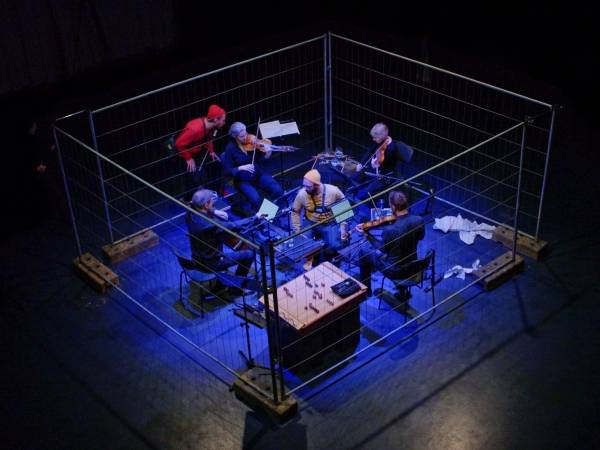3 Minuten
Introduction
Andreas Trobollowitsch's work is always somehow about movement. Either all imaginable objects are set in motion – from pens attached to walkmans, to cello bow hair on fans, to 2-meter-high platforms with musicians on top. Or a whole swarm of melodicas on 6-meter-long blowpipes at lofty heights seesaws irregularly in time, while they, played by plump balloons, produce a microtonal choir. Sometimes a piano pulled behind a tractor plows through the fields of Lower Austria.
It is clear that a certain amount of flexibility is also demanded of the audience – not least and especially with regard to their own ideas about themselves, things and, in fact, the whole world. This is because the artist's curiosity prefers to look behind the façade of the everyday; it always sees the unexpected sides of the familiar and thus opens up access to a hidden world of undreamt-of possibilities and untapped potential. (Hans-Jürgen Hauptmann)
TRUBA - HUMANTURNTABLE
The grooves of a record are traces of former sound events, frozen vibrations, trapped in time. A record is thus actually (also) a sound sculpture, whose multidimensional morphology slumbers in a two-dimensional disc. When it is set in rotation, a sensitive needle can release the spectrogram held in the spiral-shaped sound canyons – like an inverted seismograph that mirrors time and translates the recordings back into vibrations. The resulting air pressure fluctuations create space-time turbulence, atmospheric micro-detonations, some of which are strong enough to blow holes in the fabric of our everyday lives and open up brief, fragile spaces: leeway for alternative presents, rehearsal rooms for counter worlds, portals into other dimensions. A large part of Trobollowitsch's curiosity is also devoted to the sounding alchemy of rotating objects. In 2020, for example, such an object was in the small water reservoir in Berlin.
It was a sound installation based on a turntable with a diameter of 2 meters. The music that could be heard on it came from 2 trumpet players who sat facing outwards on this oversized turntable and turned in circles at a smooth 8 rpm. In doing so, they rotated at regular intervals past six holes, each 16 cm in diameter, which in turn were the openings of 4-6 meter long tubes. These were arranged radially around the sound gyroscope in a charming construction with a keen sense of Stöfflich's idiosyncrasy, ensuring that the instruments' sound impulses, organized according to a special score and enriched with the resonance energy of the built-in materials, were translated into a spacious sound topography, which encountered the wandering audience in vagrant, overlapping and mutually permeating sonic clouds, pulsating hazily and constantly changing.
A revised recording of this was captured on a record. A result, of course, that first had to be pressed back into the two-dimensionality described at the beginning, the simple form of which, however, is – as we now know – the substrate of a multi-layered conjunctive machine: a vinyl-based level of consistency that folds, deforms and condenses space and time so playfully that one gets the impression of hearing echoes from distant worlds and times – “everything everywhere all at once”.
(Hans-Jürgen Hauptmann)
hybrid #1 - ⥀18
hybrid #1 - ⥀18 is based on the sound installation hybrid #1, consisting of three specially constructed mechanical turntables, six flutes and six balloons. While the turntables rotate at different speeds, the flutes attached to them are made to sound by the air flowing out of the balloons. The installation modulates in several ways: on the one hand gradually in the microtonal range due to the constantly minimally decreasing air pressure, and on the other hand erratically when the playing mode changes from “overblowing” to the “conventional” playing mode. In addition, the overall sound image – emanating from the rapidly rotating turntables – modulates successively, causing frequencies to spread and rub against each other in space in ever-changing ways.
The version hybrid #1 -⥀18 conceived for the Mozartsaal was expanded in terms of both space and composition. On the one hand, eighteen flutes are used instead of six, and on the other, the PHACE ensemble interprets a score based on the rotating flute sound. The source material for this is frequencies and frequency sequences that have been tested and researched in advance, which are mostly based on extended playing techniques – in harmony, these sounds then shimmer quietly through, like a shadow that makes the installation appear in a permanently changing light.
The composition aims to create a single large instrument that acts as a single organism, which gradually changes, sometimes appearing louder, sometimes quieter, and, starting from microtonal, transforming soundscapes, focuses on the interplay between human (performer) and machine (installation).
Andreas Trobollowitsch
Andreas Trobollowitsch is an Austrian composer and sound artist. His current work focuses on conceptual and site-specific compositions, performances, sound objects, and drawing installations. The materials used are mostly prepared self-developed musical instruments, modified everyday objects, and plants that are activated and/or manipulated by rotation systems, performers, or changing aggregate states (e.g. melting ice). Interested in the dichotomy of the intellectual and the physical, he incorporates visual aspects, spaces, and movement, using a playful practice that focuses on experimentation and timbre. He has received the State Scholarship for Composition and was a SHAPE Artist (Innovative Music and Audiovisual Art for Europe) in 2017. Composition commissions from Ensemble PHACE Vienna, Filmarchiv Austria, Musikprotokoll Graz, Todays Art Den Haag, Contemporary Music Ensemble Synaesthesis Vilnius, and The Rhythm Method New York, among others.
Article topics
Article translations are machine translated and proofread.
Artikel von Andreas Trobollowitsch
 Andreas Trobollowitsch
Andreas Trobollowitsch 



